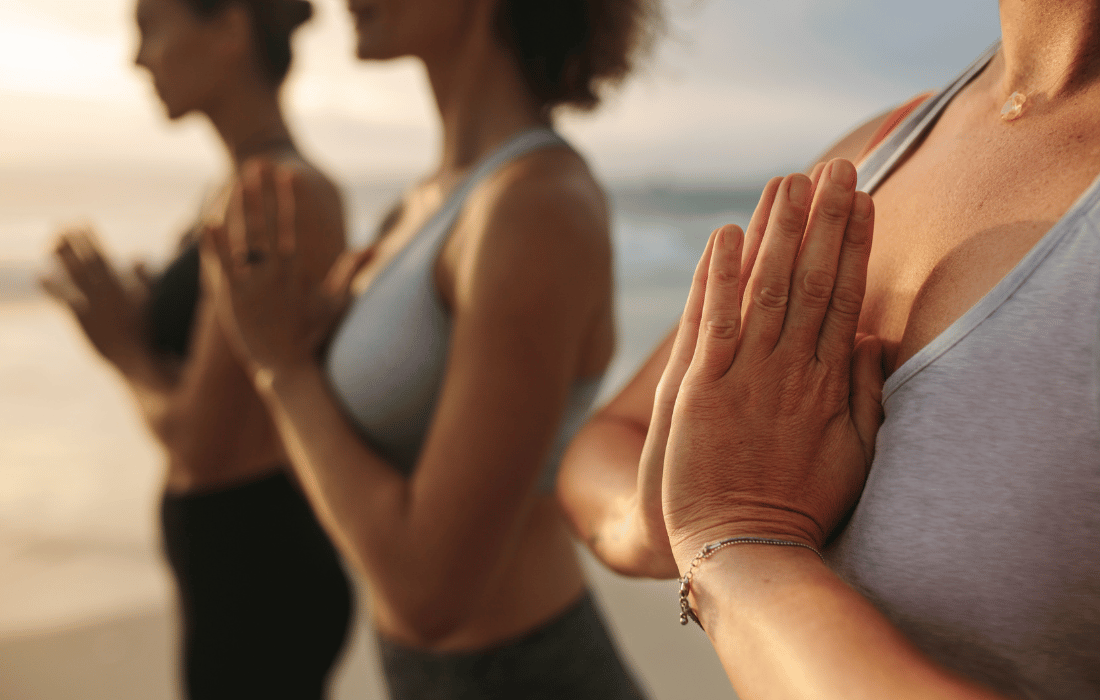1. Grounding (Earthing)
 Grounding, or earthing, is the practice of physically connecting with the Earth by walking barefoot on natural surfaces like grass, soil, or sand. This simple act allows your body to absorb the Earth’s electrons, which can help neutralize free radicals, balance the nervous system, and reduce inflammation.
Grounding, or earthing, is the practice of physically connecting with the Earth by walking barefoot on natural surfaces like grass, soil, or sand. This simple act allows your body to absorb the Earth’s electrons, which can help neutralize free radicals, balance the nervous system, and reduce inflammation.
Scientific Backing:
A study published in the Journal of Environmental and Public Health found that grounding significantly reduces pain and inflammation, improves sleep, and lowers stress levels. It can even support cardiovascular health by improving blood flow and reducing blood viscosity.
How It Works:
The Earth’s surface carries a negative charge, while free radicals (unstable atoms that cause oxidative stress) in the body have a positive charge. By grounding, you allow these excess positive charges to neutralize, helping reduce the chronic inflammation often linked to modern diseases like heart disease and autoimmune disorders.
How to Practice:
Spend at least 20 minutes a day walking barefoot on natural surfaces. If you’re near a beach, this can be especially therapeutic since water conducts electrons more efficiently. In urban areas, parks with grass are your best bet.
2. Breathwork
Breathwork is one of the most powerful, free tools for regulating your autonomic nervous system, improving mental clarity, and reducing stress. Techniques such as diaphragmatic breathing, the Wim Hof method, or even simple box breathing can help shift your body from a stress response (sympathetic nervous system) to a relaxation response (parasympathetic nervous system).
Scientific Backing:
A study from Frontiers in Human Neuroscience shows that slow, deep breathing stimulates the vagus nerve, which can decrease heart rate, lower cortisol levels, and promote a sense of calm. Additionally, Harvard Medical School has documented the benefits of breathwork for reducing anxiety, improving sleep, and enhancing cognitive function.
How It Works:
Deep, slow breathing helps increase oxygen supply to the brain, lowers heart rate, and reduces blood pressure. Breathwork also stimulates the vagus nerve, which plays a key role in calming the nervous system and balancing the stress-response system.
How to Practice:
Try deep diaphragmatic breathing for five minutes in the morning or before bed. To practice, place one hand on your chest and the other on your belly. Breathe deeply through your nose, allowing your diaphragm (not your chest) to expand. Exhale slowly through your mouth, feeling your belly deflate. Repeat for several minutes to feel more centered.
3. Sun Exposure
Sun exposure is a natural way to increase vitamin D production, a critical nutrient for bone health, immune function, and mood regulation. While too much sun can lead to skin damage, regular and moderate (at first) exposure can do wonders for your health.
Scientific Backing:
Vitamin D deficiency has been linked to increased risk of osteoporosis, autoimmune diseases, and mood disorders such as depression. Research indicates that spending just 10-20 minutes in the sun each day can improve vitamin D levels, reduce symptoms of depression, and regulate sleep-wake cycles.
How It Works:
When your skin is exposed to UVB rays from the sun, it synthesizes vitamin D3, which is then converted to its active form in the liver and kidneys. Vitamin D is essential for calcium absorption, immune regulation, and maintaining mental health. Low levels of vitamin D are also associated with seasonal affective disorder (SAD), a type of depression that occurs in winter months when sunlight is scarce.
How to Practice:
Aim for 15-30 minutes of direct sun exposure daily, ideally in the morning when the sun’s rays are less intense. You can go without sunscreen during this short period to allow for maximum vitamin D production, but be mindful not to overdo it.
4. Mindful Movement
Mindful movement—such as yoga, tai chi, or even simple stretching—can improve flexibility, reduce stress, and enhance mental clarity. Unlike high-intensity exercise, these practices encourage the mind-body connection, fostering awareness and relaxation while still offering physical benefits.
Scientific Backing:
A 2013 meta-analysis showed that yoga significantly reduces symptoms of depression and anxiety. Tai chi has also been found to improve balance, reduce falls in older adults, and enhance overall quality of life. Both practices are shown to decrease cortisol levels and boost mood.
How It Works:
Mindful movement engages both the body and mind, promoting a meditative state that reduces stress hormones and increases serotonin, the neurotransmitter associated with feelings of well-being. Additionally, mindful movement improves proprioception (body awareness), flexibility, and strength without the impact of intense workouts.
How to Practice:
Incorporate 10-20 minutes of mindful movement into your morning or evening routine. Focus on your breath as you stretch or flow through yoga poses, and allow your body to move in a way that feels intuitive and relaxing.
5. Fasting for Cellular Regeneration and Detoxification
Fasting is a free yet powerful tool for promoting cellular regeneration, enhancing detoxification, and improving metabolic health. Different forms of fasting—such as intermittent fasting (IF), prolonged fasting, or time-restricted eating—allow your body to rest from constant digestion and initiate autophagy, the body’s natural process of removing damaged cells and regenerating healthy ones.
Scientific Backing:
Fasting has been shown to enhance cellular repair processes like autophagy, as well as increase longevity markers such as improved insulin sensitivity and reduced inflammation. A 2017 study found that intermittent fasting can reduce oxidative stress and inflammation, improve metabolic markers, and even support brain health.
How It Works:
When you fast, your body shifts into a fat-burning state and activates autophagy, which allows cells to remove damaged components and replace them with healthier, more functional ones. Fasting also reduces insulin levels, promoting fat loss and improving metabolic flexibility.
Male vs. Female Fasting Differences:
Men and women respond to fasting differently due to hormonal variations. While men generally benefit from intermittent fasting with improved energy and fat loss, women may need to approach fasting more cautiously, especially if they experience hormonal imbalances or stress.
Women’s bodies are more sensitive to fasting signals, which can impact reproductive hormones if done too aggressively or frequently. Shorter fasting windows (12-14 hours) are often more suitable for women to avoid negative effects on hormone balance.
How to Practice:
Start with a 12-hour fast (e.g., from 8 PM to 8 AM) and gradually extend to 14-16 hours as your body adjusts. Pay attention to how you feel, and consult a healthcare professional if you have any concerns, especially if you are female or have underlying health conditions.
6. Cold Showers or Cold Water Therapy
Cold water therapy has gained popularity for its ability to improve circulation, reduce inflammation, and increase mental resilience. Cold exposure activates the parasympathetic nervous system, which can lower stress and enhance mood by triggering the release of endorphins.
Scientific Backing:
Research in Experimental Physiology has shown that cold water immersion improves recovery, reduces muscle soreness, and enhances mental clarity. Cold therapy has also been linked to fat loss by activating brown fat, which burns calories to generate heat.
How It Works:
Cold exposure activates thermogenesis, the process by which the body produces heat in response to cold. This not only burns calories but also stimulates the immune system, improves circulation, and increases alertness. The release of norepinephrine—a neurotransmitter that boosts focus and mood—further enhances cognitive function.
How to Practice:
Start by ending your regular shower with 30-60 seconds of cold water. If you feel adventurous, you can gradually increase the time and the water’s coldness over the weeks. This small act will not only invigorate your body but also build resilience and improve mood.
7. Time in Nature
Spending time in nature is one of the most effective ways to reduce stress, lower cortisol levels, and boost mood—all without spending a dime. Studies show that spending time in green spaces improves mental health, enhances creativity, and can even boost immune function.
Scientific Backing:
 A 2019 study in Frontiers in Psychology revealed that spending just 20 minutes in a park or green space significantly reduces cortisol levels, a marker of stress. Another study published in Environmental Health and Preventive Medicine demonstrated that forest bathing (Shinrin-yoku) enhances immune function by increasing natural killer (NK) cells that help fight viruses and cancer.
A 2019 study in Frontiers in Psychology revealed that spending just 20 minutes in a park or green space significantly reduces cortisol levels, a marker of stress. Another study published in Environmental Health and Preventive Medicine demonstrated that forest bathing (Shinrin-yoku) enhances immune function by increasing natural killer (NK) cells that help fight viruses and cancer.
How It Works:
Nature exposure calms the mind and reduces the “fight-or-flight” stress response. It also promotes the release of serotonin and dopamine, two neurotransmitters associated with happiness and relaxation. Moreover, being in nature helps restore focus and mental clarity by reducing the overstimulation common in urban environments.
How to Practice:
Spend at least 20 minutes a day outdoors, whether it’s walking through a park, hiking, or sitting in your garden. Simply being surrounded by greenery can significantly reduce stress and improve mental clarity.
8. Sleep Hygiene
Good sleep is a cornerstone of health, but poor sleep hygiene can lead to chronic stress, hormonal imbalances, and a weakened immune system. Maintaining a consistent sleep routine, minimizing blue light exposure in the evening, and creating a calming environment can significantly improve sleep quality.
Scientific Backing:
 Research published by the National Sleep Foundation found that inadequate sleep is linked to obesity, type 2 diabetes, cardiovascular disease, and even early mortality. Good sleep hygiene practices, such as avoiding screens before bed and maintaining a regular sleep schedule, can improve both the quantity and quality of sleep.
Research published by the National Sleep Foundation found that inadequate sleep is linked to obesity, type 2 diabetes, cardiovascular disease, and even early mortality. Good sleep hygiene practices, such as avoiding screens before bed and maintaining a regular sleep schedule, can improve both the quantity and quality of sleep.
How It Works:
Sleep is critical for physical and mental restoration. During sleep, your brain clears away toxins, consolidates memories, and repairs tissues. Poor sleep leads to an increase in cortisol, which can contribute to weight gain, depression, and decreased immune function.
How to Practice:
Develop a consistent wind-down routine by dimming the lights, avoiding screens, and engaging in relaxing activities such as reading, meditation, or deep breathing. Aim for 7-9 hours of sleep per night.
9. Journaling and Gratitude
Journaling and practicing gratitude are free yet powerful ways to enhance mental health and emotional resilience. Writing down your thoughts helps clear mental clutter, while expressing gratitude boosts happiness, optimism, and even physical health.
Scientific Backing:
A study published in the Journal of Personality and Social Psychology found that people who regularly practiced gratitude experienced higher levels of well-being, lower levels of depression, and improved sleep quality. Similarly, research shows that expressive writing (like journaling) helps process emotions and reduce stress.
How It Works:
Gratitude practices shift your focus from what you lack to what you have, promoting a positive mindset and improving overall life satisfaction. Journaling helps organize thoughts, solve problems, and provide clarity by engaging in reflective thought processes. Both practices encourage mindfulness and emotional regulation.
How to Practice:
Spend 5-10 minutes each day journaling about your thoughts or reflecting on what you’re grateful for. Write down at least three things you’re grateful for each day to foster a more positive outlook on life.
10. Deep Connection (Social or Spiritual)
Human connection is crucial for both mental and physical health. Strong social bonds improve emotional resilience, reduce stress, and promote longevity. Whether through meaningful conversations with loved ones or nurturing your spiritual practice, connecting deeply with others or a higher power can profoundly impact your well-being.
Scientific Backing:
Several studies have found that strong relationships are the most important predictor of long-term happiness and health. Social connections boost oxytocin levels (the “love hormone”), which reduces cortisol and enhances feelings of safety and security. Similarly, research on spirituality suggests that people with strong spiritual or religious practices tend to experience lower rates of anxiety, depression, and substance abuse.
How It Works:
Positive social interactions stimulate the release of oxytocin and serotonin, two neurotransmitters that promote happiness and reduce stress. Spiritual practices such as prayer, meditation, or mindfulness engage the brain’s default mode network, promoting relaxation, focus, and emotional stability.
How to Practice:
Make time for meaningful social interactions, whether it’s through a phone call, in-person visit, or virtual meeting. If spirituality resonates with you, engage in daily prayer, meditation, or reflection to foster inner peace and a sense of purpose.
Conclusion: Simple, Free, and Transformative
Incorporating these free, holistic self-care practices into your daily life can dramatically improve your well-being without costing a penny. These tips are not only grounded in nature and biology but are also backed by science to ensure their effectiveness. By consistently integrating these practices into your routine, you can build resilience, reduce stress, and foster a deeper connection with yourself and the world around you. Whether it’s spending time in nature, practicing mindfulness, or simply drinking more water, these simple habits can lead to profound, lasting change. Start today, and watch as your health and happiness thrive!








